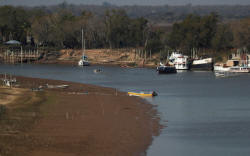'Once in 100 years' drought seen affecting Argentine
grains exports into next year
 Send a link to a friend
Send a link to a friend
 [August 12, 2021] By
Hugh Bronstein [August 12, 2021] By
Hugh Bronstein
BUENOS AIRES (Reuters) - A once-a-century
drought has lowered the water level of Argentina's main grains transport
river, reducing farm exports and boosting logistics costs in a trend
that meteorologists said will likely continue into next year.
The South American grains powerhouse is the world's No. 3 corn supplier
and No. 1 exporter of soymeal livestock feed, used to fatten hogs and
poultry from Europe to Southeast Asia. Farm exports are Argentina's main
source of hard currency needed to bolster central bank reserves sapped
by a three-year recession.
Southern Brazil, source of the Parana River, has been hit by drought for
three years. This has reduced water levels in the Argentine ports hub of
Rosario, Santa Fe province, where about 80% of the country's
agricultural exports are loaded.
"This is about a once-in-a-hundred-years event. That's the type of
frequency we are looking at," said Isaac Hankes, a weather analyst at
Refinitiv, financial and risk business of Thomson Reuters.

On Monday the United Nations climate panel's report found that climate
change is making extreme weather events more common. One meteorologist
told Reuters the situation could "even get worse after the rainy season"
set to start in late September.
Ships sailing from Rosario are loading 18% to 25% less cargo than normal
due to the shallow water, said Guillermo Wade, manager of Argentina's
Chamber of Port and Maritime Activities.
Logistics costs are rising as more soy and corn must be trucked to the
Atlantic ports of Bahia Blanca and Necochea, in southern Buenos Aires
province, where ships make a final stop to be topped off with cargo
before heading out to sea.
GIMME SOME WATER
The drying trend in Brazil started in 2019. The next year was drier and
2021 has been the driest of the three years, Hankes said. The effect on
the river is cumulative.
Over the last 12 months the Parana River basin has gotten only 50% to
75% of normal rainfall.
[to top of second column] |

Boats are seen on the shore of the Parana River, in Rosario,
Argentina July 8, 2021. The lack of rain in Brazil, where the river
originates, has brought water levels down in Argentina, forcing
cargo ships to reduce the amount of grains that are loaded for
export. REUTERS/Agustin Marcarian/

"We would need something like 130% of normal rainfall between now and February
to replenish river levels. Anything less than 100% would be bad news for the
river basin, and between now and February we expect maybe 80% of normal
rainfall," Hankes said.
"We do expect to see a wetter trend once we get into October-November, which you
would typically see in the wet season anyway. But after that our best
indications right now are that we could see a similar pattern to last year,"
Hankes added.
The usually rainy Southern Hemisphere spring starts in September and ends in
December. But the coming increase in water is expected to only temporarily help
refresh the Parana.
"It could even get worse after the rainy season," said German Heinzenknecht, a
meteorologist at consultancy Applied Climatology.
"This shallow level of the waterway is historic, and it is hard to predict when
it could be reversed," Heinzenknecht added.
A top Argentine oilseeds executive with an international exporter with major
crushing operation in Rosario agreed that the Parana crisis will probably
continue next year. The executive asked not to be named, as per company policy.
"The situation will remain critical until October, improving in the late fourth
quarter and first quarter. But from April onward, when Argentina's soy and corn
harvest starts, and the biggest number of cargo vessels are expected, the river
at Rosario will be back to a scenario similar to 2021," the executive said.
(Reporting by Hugh Bronstein and Maximilian Heath; Editing by David Gregorio)
[© 2021 Thomson Reuters. All rights
reserved.] Copyright 2021 Reuters. All rights reserved. This material may not be published,
broadcast, rewritten or redistributed.
Thompson Reuters is solely responsible for this content.
 |